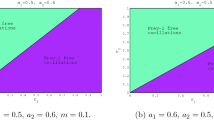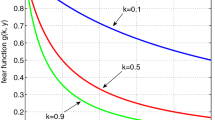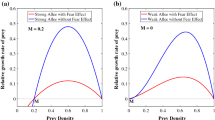Abstract
In this article, we have analysed a two-prey–one-predator system in which predator feeds on the more abundant prey species (switching in predation) and also the reproduction of both prey species is greatly reduced by the presence of predator (fear affect). The goal of this work is to investigate the dynamical characteristics of the system in both deterministic and stochastic environments. Well-posedness of the deterministic system has been justified by analysing the basic dynamical properties of that system. Stability conditions at various feasible equilibrium points are derived in terms of model parameters. The impact of parametric fluctuation has also been investigated on the model dynamics by using local bifurcation analysis. We also have studied the proposed model in a fluctuating environment by considering death rate of each species as stochastic parameter. Our mathematical findings have been justified and illustrated through numerical simulation.














Similar content being viewed by others
Data availability
The data used to support the findings of the study are available within the article.
References
Cresswell W (2011) Predation in bird populations. J Ornithol 152:251–263
Mondal S, Samanta GP (2021) Impact of fear on a predator-prey system with prey-dependent search rate in deterministic and stochastic environment. Nonlinear Dyn 104:2931–2959. https://doi.org/10.1007/s11071-021-06435-x
Sahoo D, Samanta G, De la Sen M (2021) Impact of fear and habitat complexity in a predator-prey system with two different shaped functional responses: A comparative study. Discret Dyn Nat Soc 2021:6427864. https://doi.org/10.1155/2021/6427864
Saha S, Samanta GP (2020) A prey-predator system with disease in prey and cooperative hunting strategy in predator. J Phys A: Math Theor 53(48):485601
Malthus TR (1798) An essay on the principle of population as it affects the future improvement of society, with remarks on the speculations of Mr. Godwin, M. Condorcet, and other writers. The Lawbook Exchange Ltd
Verhulst PF (1838) Notice sur la loi que la population suit dans son accroissement. Corresp Math Phys 10(2):113–126. https://doi.org/10.1016/j.mbs.2012.11.007
Lotka AJ (1925) Elements of physical biology. Williams and Wilkins company
Volterra V (1927) Variazioni e fluttuazioni del numero d’individui in specie animali conviventi. Memoria della Reale Accademia Nazionale dei Lincei
Rosenzweig ML, MacArthur RH (1963) Graphical representation and stability conditions of predator-prey interactions. Am Nat 97(895):209–223
Creel S, Christianson D, Liley S, Winnie JA (2007) Predation risk affects reproductive physiology and demography of elk. Science 315(5814):960. https://doi.org/10.1126/science.1135918
Das BK, Sahoo D, Samanta GP (2022) Impact of fear in a delay-induced predator-prey system with intraspecific competition within predator species. Math Comput Simul 191:134–156. https://doi.org/10.1016/j.matcom.2021.08.005
Mondal S, Samanta GP (2020) Dynamics of a delayed predator-prey interaction incorporating nonlinear prey refuge under the influence of fear effect and additional food. J Phys A: Math Theor 53(29):295601
Mondal S, Samanta GP, Nieto JJ (2021) Dynamics of a predator-prey population in the presence of resource subsidy under the influence of nonlinear prey refuge and fear effect. Complexity 2021:9963031. https://doi.org/10.1155/2021/9963031
Sweitzer RA, Jenkins SH, Berger J (1997) Near-extinction of porcupines by mountain lions and consequences of ecosystem change in the great basin desert. Conserv Biol 11(6):1407–1417. https://doi.org/10.1046/j.1523-1739.1997.96138.x
Cook DB, Hamilton WJ (1944) The ecological relationships of red fox food in eastern new york. Ecology 25(1):91–104. https://doi.org/10.2307/1930765
Murdoch WW (1969) Switching in general predators: experiments on predator specificity and stability of prey populations. Ecol Monogr 39(4):335–354. https://doi.org/10.2307/1942352
Tansky M (1978) Switching effect in prey-predator system. J Theor Biol 70(3):263–271. https://doi.org/10.1016/0022-5193(78)90376-4
Prajneshu, Holgate P (1987) A prey-predator model with switching effect. J Theoret Biol 125(1):61–66. https://doi.org/10.1016/S0022-5193(87)80179-0
Saha S, Samanta G (2021) Modelling of a two prey and one predator system with switching effect. Comput Math Biophys 9:90–113. https://doi.org/10.1515/cmb-2020-0120
Zanette LY, White AF, Allen MC, Clinchy M (2011) Perceived predation risk reduces the number of offspring songbirds produce per year. Science 334(6061):1398–1401. https://doi.org/10.1126/science.1210908
Elliott KH, Betini GS, Norris DR (2017) Fear creates an allee effect: experimental evidence from seasonal populations. Proc R Soc B Biol Sc 284(1857):20170878. https://doi.org/10.1098/rspb.2017.0878
Suraci JP, Clinchy M, Dill LM, Roberts D, Zanette LY (2016) Fear of large carnivores causes a trophic cascade. Nat Commun 7:10698. https://doi.org/10.1038/ncomms10698
Wang X, Zanette L, Zou X (2016) Modelling the fear effect in predator-prey interactions. J Math Biol 73:1179–1204. https://doi.org/10.1007/s00285-016-0989-1
Das A, Samanta GP (2018) Modeling the fear effect on a stochastic prey-predator system with additional food for predator. J Phys A Math Theor 51(46):465601. https://doi.org/10.1088/1751-8121/aae4c6
Sahoo D, Samanta GP (2021) Impact of fear effect in a two prey-one predator system with switching behaviour in predation. Differ Equ Dyn Syst. https://doi.org/10.1007/s12591-021-00575-7
Lande R (1993) Risks of population extinction from demographic and environmental stochasticity and random catastrophes. Am Nat 142(6):911–927
May RM (1973) Stability in randomly fluctuating versus deterministic environments. Am Nat 107(957):621–650
Xia Y, Yuan S (2020) Survival analysis of a stochastic predator-prey model with prey refuge and fear effect. J Biol Dyn 14(1):871–892. https://doi.org/10.1080/17513758.2020.1853832
Das A, Samanta GP (2018) Stochastic prey-predator model with additional food for predator. Physica A 512:121–141. https://doi.org/10.1016/j.physa.2018.08.138
Khan QJA, Balakrishnan E, Wake GC (2004) Analysis of a predator-prey system with predator switching. Bull Math Biol 66(1):109–123
Tiwari PK, Al Amri KAN, Samanta S, Khan QJA, Chattopadhyay J (2021) A systematic study of autonomous and nonautonomous predator–prey models with combined effects of fear, migration and switching. Nonlinear Dyn 103(2):2125–2162
Samanta GP (1996) Influence of environmental noises on the gomatam model of interacting species. Ecol Model 91(1–3):283–291
Samanta GP (1991) Stochastic analysis of a noisy oscillator. Appl Math Lett 4(2):61–63
Bera SP, Maiti A, Samanta GP (2016) Stochastic analysis of a prey-predator model with herd behaviour of prey. Nonlinear Anal Modell Control 21(3):345–361
Liu G, Qi H, Chang Z, Meng X (2020) Asymptotic stability of a stochastic may mutualism system. Comput Math Appl 79(3):735–745
Hale JK (1977) Theory of functional differential equations. Springer, New York
Perko L (2013) Differential equations and dynamical systems, vol 7. Springer Science & Business Media
Das A, Samanta GP (2020) A prey-predator model with refuge for prey and additional food for predator in a fluctuating environment. Physica A Stat Mech Appl. https://doi.org/10.1016/j.physa.2019.122844
Mao X (2011) Stochastic differential equations and applications. WOODHEAD PUBLISHING, Oxford
Barbalat I (1959) Systems d’equations differentielles d’oscillations nonlinearies. Revue Roumaine des Mathematiques Pures et Appliquees 4(2):267–270
Ji C, Jiang D (2011) Dynamics of a stochastic density dependent predator-prey system with Beddington–Deangelis functional response. J Math Anal Appl 381:441–453. https://doi.org/10.1016/j.jmaa.2011.02.037
Acknowledgements
The authors are grateful to the anonymous referees and Professor Jian-Qiao Sun (Editor-in-Chief) for their valuable comments and helpful suggestions, which have helped them to improve the presentation of this work significantly. The research of J.J. Nieto has been partially supported by the Agencia Estatal de Investigacion (AEI) of Spain, cofinanced by the European Fund for Regional Development (FEDER) corresponding to the 2014-2020 multiyear financial framework, project PID2020-113275GB-I00; and by Xunta de Galicia under grant ED431C 2019/02.
Author information
Authors and Affiliations
Corresponding author
Ethics declarations
Conflict of interest
The authors declare that they have no conflict of interest regarding this work.
Rights and permissions
Springer Nature or its licensor holds exclusive rights to this article under a publishing agreement with the author(s) or other rightsholder(s); author self-archiving of the accepted manuscript version of this article is solely governed by the terms of such publishing agreement and applicable law.
About this article
Cite this article
Das, A., Sahoo, D., Samanta, G. et al. Deterministic and stochastic analysis of a two-prey–one-predator system with fear effect and switching behaviour in predation. Int. J. Dynam. Control 11, 1076–1101 (2023). https://doi.org/10.1007/s40435-022-01028-x
Received:
Revised:
Accepted:
Published:
Issue Date:
DOI: https://doi.org/10.1007/s40435-022-01028-x




